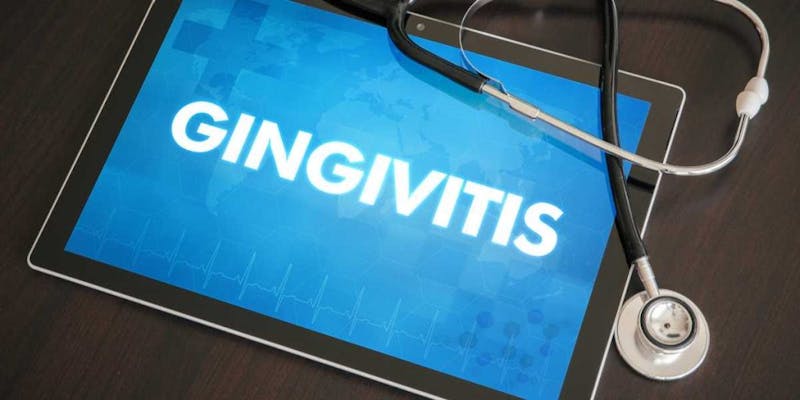
Gingivitis is the most frequent periodontal disease, affecting almost 100% of the population at some point in its life.Periodontal diseases affect 8 out of 10 adults. Among them, gingivitis is especially common, but it can be identified, prevented and treated in a very simple way.
It´s a group of disorders that affect the periodontium, that is, the tissues that support the teeth. They are produced mainly by the action of bacteria that accumulate on the teeth, gums, restorations …, forming a thin layer known as dental plaque or dental biofilm. In the case that the infection produced by these bacteria affects only the gingiva, they cause a “reversible” inflammatory process called gingivitis. But if the infection stays long and/or is associated with other risk factors, it may progress (in those most predisposed) to periodontitis.
Periodontitis is a deeper infection in which there is destruction of the bone that is attached to the tooth, an irreversible process that can also increase the risk of onset and influence the evolution of other systemic diseases (affecting other parts of the body located outside of the oral cavity).That is why it is essential to prevent gingivitis or, if not, to detect and treat it as soon as possible.
Gingivitis is the most frequent periodontal disease, affecting practically 100% of the population at some point in its life. That is why, usually not given too much importance, in addition to the fact that does not usually cause discomfort or pain.
A sign of alarm that can warn about the presence of this disorder is the bleeding of the gums. And is that, a healthy gingiva should not bleed and, if it does, it´s because something is not right.
Most patients attribute bleeding to brushing with a certain type of brush (harder) or the technique used (stronger), without knowing that the cause of bleeding is a disease of their gums and that it should be treated.
If we have gingivitis, the gingiva will look red (not pink), swollen, shiny (losing the orange-pear-shaped dotting that characterizes the healthy gingiva) and bleeds when brushing, biting certain foods or even spontaneously (At night, while we sleep as it mixes with the saliva to stain the pillow of the bed). These changes occur as a result of increased vascularization in the area, although they do not always occur in all patients.
In this regard, special emphasis should be placed on the fact that, if you are a smoker, these signs are not so obvious, since gingivitis is camouflaged by tobacco, which makes it difficult to detect them early. Thus, since this harmful habit triples the risk of periodontal disease, if you are a smoker you think that a simple visit to the dentist will be enough to detect the presence of inadequate levels of bacterial plaque and gingival inflammation.
Groups of greater risk
Gingivitis, in its different degrees of severity, is practically universal in children (reaches 70% in children aged 7 years) and adolescents (it rises to 90% at 10 years). Although these gum disorders in children do not usually acquire a serious profile, it is considered essential to diagnose them at an early age to begin instilling good hygiene habits from infancy and avoiding a possible progression of gum disease over time.
Although gingivitis also affects a large number of adults, in the case of women it has particular consequences. The female sex is especially susceptible to this gum disease due to the hormonal changes it undergoes throughout its life (puberty, pregnancy, taking of contraceptives as well as in the menopause); these hormonal changes favor an exaggerated inflammatory response to the action of bacteria. This is especially significant because of the possible repercussions of a periodontal infection in pregnancy.
Can gingivitis be prevented?
Yes, very simply. The basis of prevention is the realization of an adequate daily dental hygiene, ideally under an appropriate advice and following specific recommendations for each person. Once the disease has appeared, specific treatments may be necessary in the dental office in order to eliminate the bacteria that are deposited in the oral cavity, as well as create the right conditions so that these do not accumulate in excess and so that the Gum disease can be maintained in the long term.
Basic care
As basic care to be taken to prevent gum disease and to maintain optimal oral health, it is advisable to apply the so-called “Rule of 2”.To achieve adequate oral hygiene, teeth and gums should be brushed for at least 2 minutes at least 2 times a day and periodic visits to the dental clinic at least twice a year.
7 tips to take care of our oral health
- – Brush teeth and tongue at least twice a day, being the most important brushing at night, before bed.
- – Only brushing is unable to eliminate all plaque, being essential in all cases the use of some method of hygiene between teeth (such as dental wire / dental tape or interdental brushes).
- – The use of a mouthwash can be in some cases an adequate complement of hygiene, always following the recommendation of your dentist.
- – The prevention of periodontal diseases is a lifelong commitment; the mechanical removal of plaque should be daily and should be accompanied by other measures aimed at avoiding additional risks for oral health.
- – Go to the dentist or periodontist at least once a year to check the condition of the gums and teeth; this will allow to prevent possible dental pathologies, periodontal and the maintenance of good general health.
- – A healthy way of life should be followed, avoiding factors harmful to oral health, such as the consumption of foods with a high content of sugars, alcohol, tobacco, and stress.
- – Avoid self-medication with oral health products in the absence of a correct diagnosis and professional advice.
Share with

